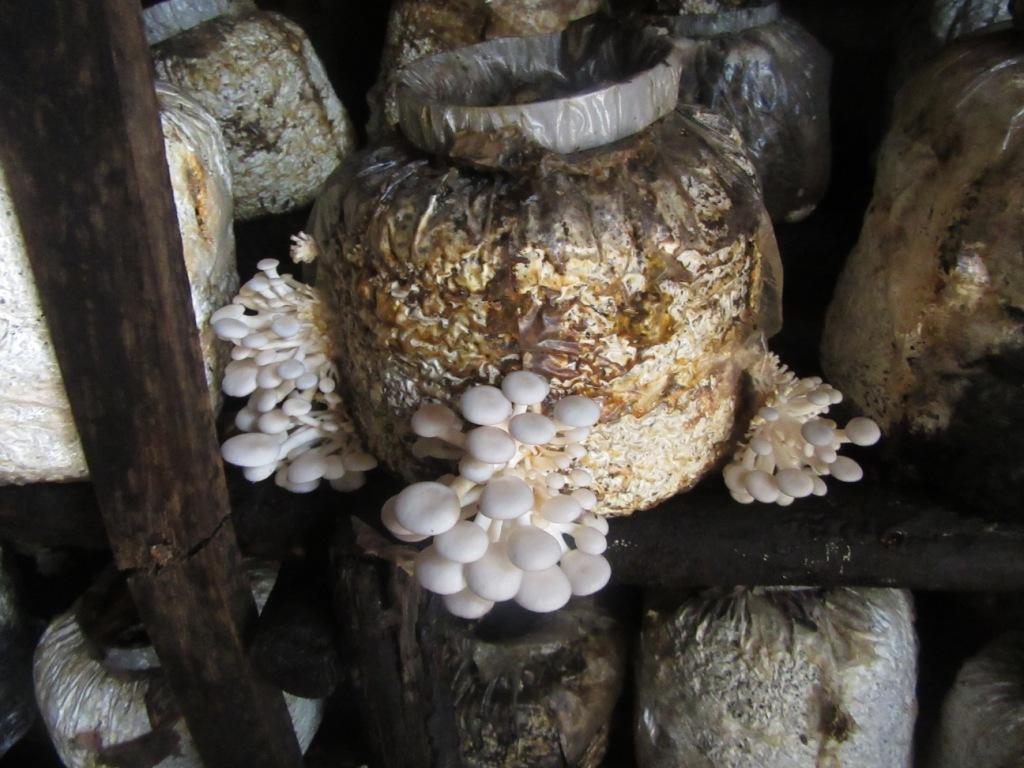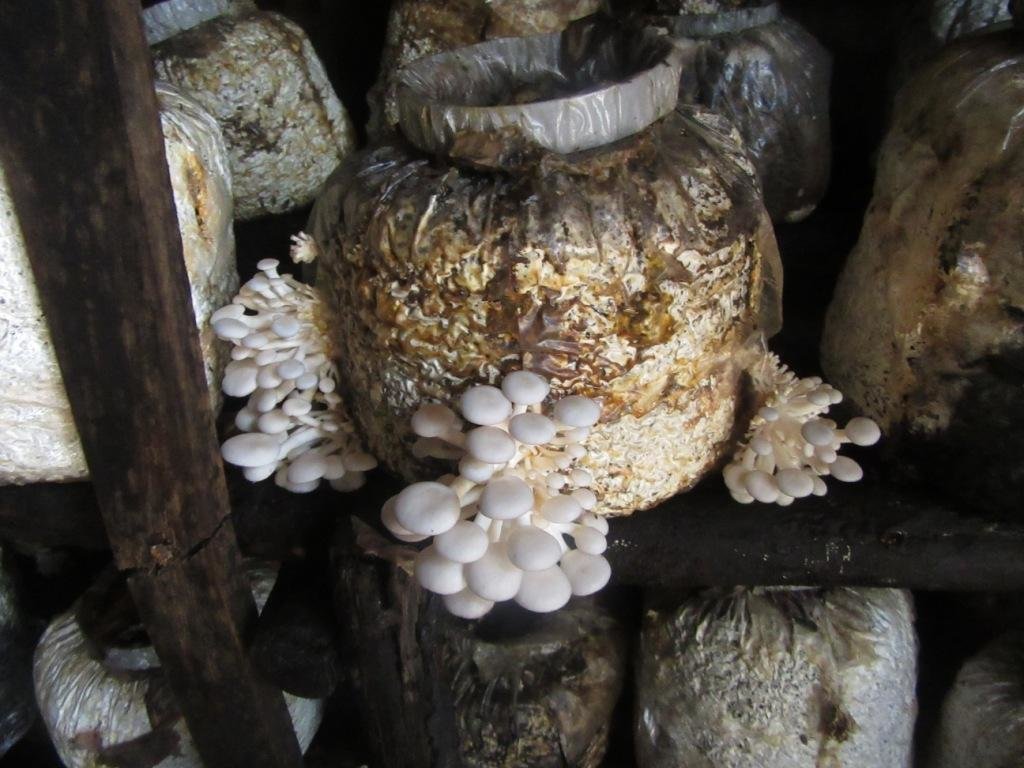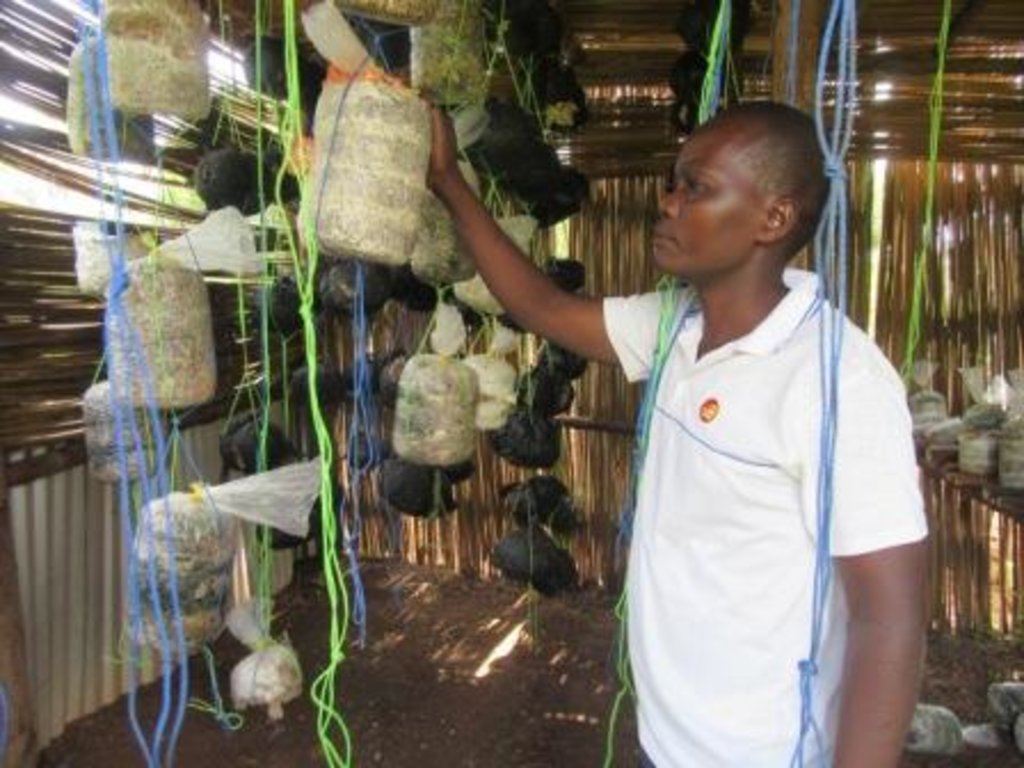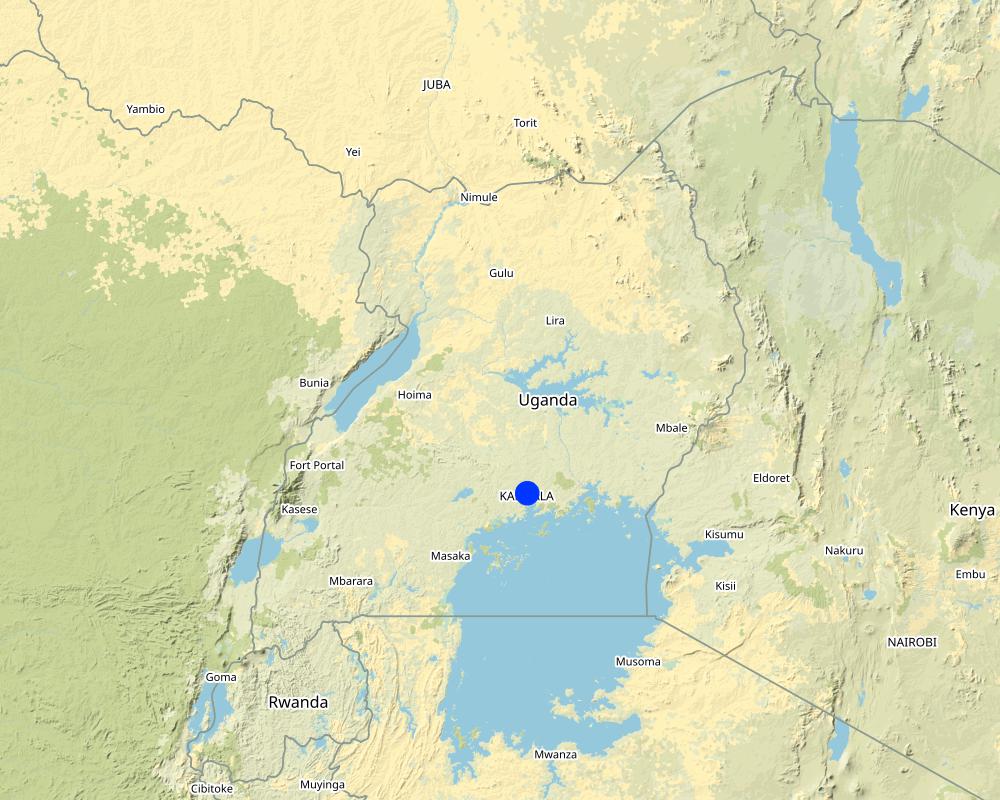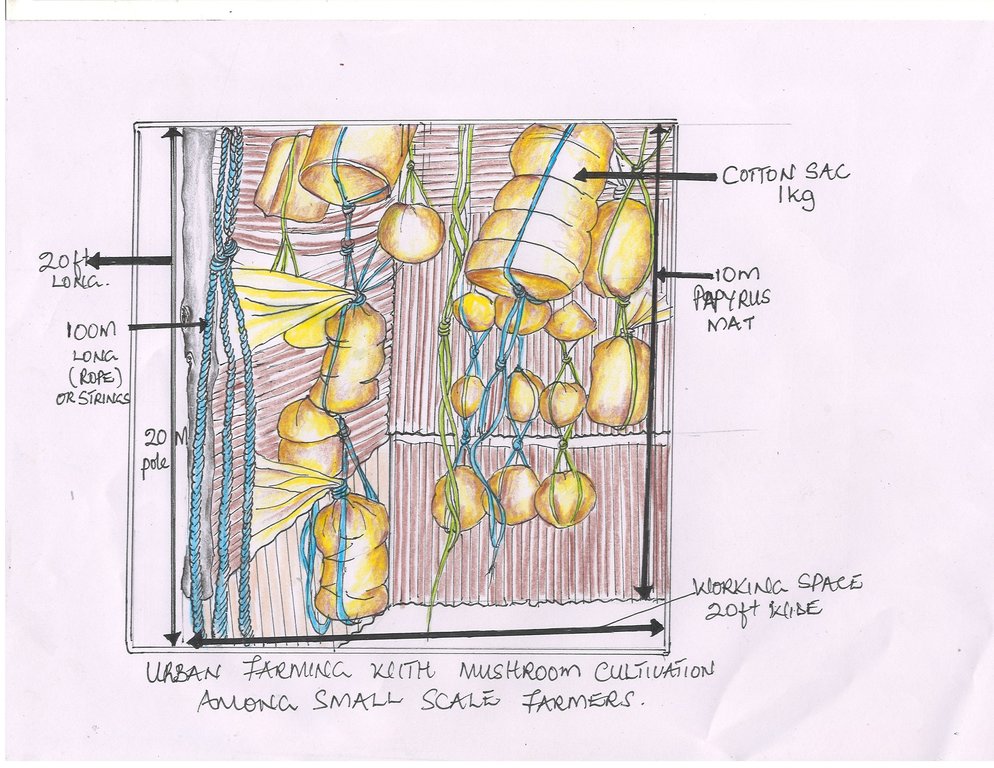Urban Farming with Mushroom Cultivation among Smallholder Farmers. [Ouganda]
- Création :
- Mise à jour :
- Compilateur : Sarah Babirye
- Rédacteurs : Jalia Namakula, Kamugisha Rick Nelson
- Examinateurs : Nicole Harari, Udo Höggel
Okulima obutiko
technologies_3450 - Ouganda
Voir les sections
Développer tout Réduire tout1. Informations générales
1.2 Coordonnées des personnes-ressources et des institutions impliquées dans l'évaluation et la documentation de la Technologie
Personne(s)-ressource(s) clé(s)
exploitant des terres:
Grace Komuhangi
0782524325
Kamyokya farmers group
Kamyokya, Kisenyi Kampala
Ouganda
Nom du projet qui a facilité la documentation/ l'évaluation de la Technologie (si pertinent)
Scaling-up SLM practices by smallholder farmers (IFAD)Nom du ou des institutions qui ont facilité la documentation/ l'évaluation de la Technologie (si pertinent)
National Agricultural Research Organisation (NARO) - Ouganda1.3 Conditions relatives à l'utilisation par WOCAT des données documentées
Quand les données ont-elles été compilées (sur le terrain)?
12/5/2017
Le compilateur et la(les) personne(s) ressource(s) acceptent les conditions relatives à l'utilisation par WOCAT des données documentées:
Oui
1.4 Déclaration sur la durabilité de la Technologie décrite
Est-ce que la Technologie décrite ici pose problème par rapport à la dégradation des terres, de telle sorte qu'elle ne peut pas être déclarée comme étant une technologie de gestion durable des terres?
Non
Commentaires:
The technology is not problematic with regard to land degradation.
2. Description de la Technologie de GDT
2.1 Courte description de la Technologie
Définition de la Technologie:
Mushroom (agaricus bisporus) cultivation is one of the profitable technologies promoted by small and medium scale farmers in urban setting fetching good returns on investment within a period of 30 days with the aim of obtaining tremendous nutritional benefits, employment and additional income gained by both farmers and suppliers of raw materials thus supporting the local economy and contributing to subsistence food security.
2.2 Description détaillée de la Technologie
Description:
Mushroom cultivation is a preferred and promoted technology by small and medium scale farmers with less land holdings. The technology has the portential to generate considerable nutritional benefits, employment and additional income which, in return, is invested in sustainable land management practices. To date, the demand for mushrooms increases as the result of a fast population growth having less income and food supply. Hence, a growing number of farmers adopt the mushroom production technology.
To establish such a technology, materials required include: cotton, a metallic drum (100 litres), a gunny bag of the size of 100kg, water, tarpuline, lime/maize brand, polyethene bags, banana leaf stock, cooking stove, firewood, mushroom seeds, tooth picks/nails and strings of approx. 100m length.
Listed below are the activities / procedures required for the establishment of a mushroom cultivation in a homestead.
-Water-soak the cotton into the drum and cover the drum with a gunny bag
-Remove the water out of the drum. The soaked cotton remains in the drum for around 2 hours
-Remove the soaked cotton on to a taurpline sheet and mix it with cultural lime/rice brand /maze brand that is placed on the taurpline
-Get black polythene bags and pack 1 kg of cotton into each polythene bag
-Place the banana leaf stock at the bottom of the drum and fill it with 20 litres of water
-Cut the gunny bag in the middle and cover the inside part of the drum to prevent burning of the cotton in the polythene bags while boiling
-Place the cotton in polythene bags into the drum and put the drum on the cooking stove to heat. The first line of polythene bags should be bent to prevent boiling water to enter the cotton
-Cover the drum tight with gunny bags
-Steam for around 2 hours
-Remove the firewood to cool until the next day
-Then remove the cooled cotton and place it on the tarpuline
-Buy mushroom seeds, smash the seeds (i.e, one pack of seeds mixes 2 gardens)
-Each kg of cotton mixed containing the mushroom seeds should be squeezed into the black polythene bags in a ball shape and tied on top
-Then get a tooth pick or a nail and pinch down 3 to 4 holes for air to come out
-Tie strings to the packed polythene bags and hang them for 14 days. (Strings enable sprouting on the gardens from all sides). Having moderate light, water needs to be applied twice a day or thrice in case of dry season during a period of 3 weeks
-After 7 days, the mushrooms start sprouting
-Leave the mushroom on the garden for 2-3 days before harvesting
-Once mushrooms are ripe, get a sharp knife and cut the stem carefully
On harvesting, the first week yields 8 Kg every second day, thereafter 3 kg of mushrooms every second day during the second month. Drums can be replaced every after 4 months so that the cost of maintenance is kept relatively low.
Mushrooms are a source of nutrients and proteins (Protein content, 3-7% when fresh and 25- 40% when dry). They are useful in preventing diseases and have medicinal values. Environmentally, the growing of mushrooms reduces pollution through bio-conservation and improves on crop production since harvested manure from the used mushroom ‘garden’ can be recycled as fertilizers for vegetable gardens at homes.
Despite the advantages, the technology faces various challenges: These include lack of a workplace (physical facility), lack of finance and skills on hygiene and sterilization, compost preparation, market challenges that include instability and decrease in sales prices of the products and inputs. Environmental factors like humidity, Ph, light and ventilation if not controlled may influence the growing process. Insects, diseases and animals due to the enclosed environment in which the mushrooms grow are a high risk. This may result in disease infestations like snails infestation.
However, maintenance costs of this technology are cheaper compared to establishment costs with minimum costs required for replacing worn out poles, replacing drums which can be at least every after 5 months.
2.3 Photos de la Technologie
2.4 Vidéos de la Technologie
Lieu:
Kamwokya, Kisenyi/Kampala
Nom du vidéaste:
Babirye Sarah
2.5 Pays/ région/ lieux où la Technologie a été appliquée et qui sont couverts par cette évaluation
Pays:
Ouganda
Région/ Etat/ Province:
Kampala
Autres spécifications du lieu:
Kamwokya, Kisenyi
Map
×2.6 Date de mise en œuvre de la Technologie
Si l'année précise est inconnue, indiquez la date approximative: :
- il y a moins de 10 ans (récemment)
2.7 Introduction de la Technologie
- A friend
Commentaires (type de projet, etc.) :
Manure harvested from used up mushroom gardens is used as fertilizers in vegetable gardens.
3. Classification de la Technologie de GDT
3.1 Principal(aux) objectif(s) de la Technologie
- améliorer la production
- créer un impact économique positif
- créer un impact social positif
3.2 Type(s) actuel(s) d'utilisation des terres, là où la Technologie est appliquée

Implantations, infrastructures
- Habitats, buildings
3.3 Informations complémentaires sur l'utilisation des terres
Commentaires:
The technology is practiced in buildings hence it doesn't require water from the rain or any irrigation source.
Nombre de période de croissance par an: :
- 1
Précisez:
Once a month, so 12 seasons in a year
3.4 Groupe de GDT auquel appartient la Technologie
- Jardins/ potagers familiaux
3.5 Diffusion de la Technologie
Spécifiez la diffusion de la Technologie:
- appliquée en des points spécifiques ou concentrée sur une petite surface
Commentaires:
Mushroom are grown on a small area.
3.6 Mesures de GDT constituant la Technologie

autres mesures
Commentaires:
Indoor mushroom cultivation. Residues from the gardens on which mushrooms grow can be recycled for fertilizers which can later be applied onto lands or homestead gardens to improve on soil fertility.
3.7 Principaux types de dégradation des terres traités par la Technologie

autre
3.8 Prévention, réduction de la dégradation ou réhabilitation des terres dégradées
Spécifiez l'objectif de la Technologie au regard de la dégradation des terres:
- non applicable
4. Spécifications techniques, activités, intrants et coûts de mise en œuvre
4.1 Dessin technique de la Technologie
4.2 Spécification/ explications techniques du dessin technique
The technical drawing shows the mushroom technology with the following dimensions and inputs required for establishment; a working place (room) of 20 feet long *20 feet wide
One timber of 10 m long length, one tarpaulin of 20 m length *20 m width, strings/ropes of 100m length in total, 10m papyrus mats (2) , polythene bags (of 1 kg ), nails (2 kgs), one drum and 5 bags of cement and 20 gardens.
4.3 Informations générales sur le calcul des intrants et des coûts
Spécifiez la manière dont les coûts et les intrants ont été calculés:
- par entité de la Technologie
Précisez l'unité:
A mushroom growing hut containing a number of mushroom gardens
Spécifiez le volume, la longueur, etc. (si pertinent):
20feet long *20feet wide for a room where mushrooms are grown as shown in the picture
autre/ monnaie nationale (précisez):
Uganda shillings
Indiquer le taux de change du dollars en monnaie locale (si pertinent): 1 USD= :
3600,0
Indiquez le coût salarial moyen de la main d'œuvre par jour:
3000/= per day
4.4 Activités de mise en place/ d'établissement
| Activité | Type de mesures | Calendrier | |
|---|---|---|---|
| 1. | Construction of a room of approximately 20*20feet | Structurel | Once through out the buisness enterprise |
| 2. | Buying equipments like drum,cotton,garden,jerricans,tarpauline,polythen bags | Structurel | Once through out the business enterprise |
| 3. | Hanging strings in the structure | Structurel | Once through out the busness enterprise |
Commentaires:
Most of the activities for mushroom growing are cost effective. This is because these items and activities are done once on commencement.
4.5 Coûts et intrants nécessaires à la mise en place
| Spécifiez les intrants | Unité | Quantité | Coûts par unité | Coût total par intrant | % du coût supporté par les exploitants des terres | |
|---|---|---|---|---|---|---|
| Main d'œuvre | Making a structure | Man day | 1,0 | 30000,0 | 30000,0 | 100,0 |
| Main d'œuvre | Hanging strings | Man day | 1,0 | 10000,0 | 10000,0 | 100,0 |
| Equipements | Drum | piece | 1,0 | 50000,0 | 50000,0 | 100,0 |
| Equipements | Cotton | piece | 2,0 | 25000,0 | 50000,0 | 100,0 |
| Equipements | Polythen bags | piece | 2,0 | 3000,0 | 6000,0 | 100,0 |
| Equipements | Jerricans | piece | 4,0 | 5000,0 | 20000,0 | 100,0 |
| Matériaux de construction | Strings | piece | 5,0 | 3000,0 | 15000,0 | 100,0 |
| Matériaux de construction | Poles | piece | 20,0 | 3000,0 | 60000,0 | 100,0 |
| Matériaux de construction | Nails | Kg | 3,0 | 5000,0 | 15000,0 | 100,0 |
| Matériaux de construction | Papyrus mats | piece | 10,0 | 7000,0 | 70000,0 | 100,0 |
| Autre | Tarpuline | piece | 1,0 | 20000,0 | 20000,0 | 100,0 |
| Autre | Seed packs | piece | 50,0 | 2000,0 | 100000,0 | 100,0 |
| Autre | Maize brand | Kg | 10,0 | 1000,0 | 10000,0 | 100,0 |
| Autre | Cultural lime | Kg | 1,0 | 15000,0 | 15000,0 | 100,0 |
| Autre | Water | piece | 10,0 | 300,0 | 3000,0 | 100,0 |
| Autre | Firewood | piece | 5,0 | 2000,0 | 10000,0 | 100,0 |
| Coût total de mise en place de la Technologie | 484000,0 | |||||
Si le coût n'est pas pris en charge à 100% par l'exploitant des terres, indiquez qui a financé le coût restant:
National Agriculrueal Advisory Services (NAAD supported her with the drum).
Commentaires:
The initial cost is relatively high for low income farmers although most acquire loans through farmer groups.
4.6 Activités d'entretien/ récurrentes
| Activité | Type de mesures | Calendrier/ fréquence | |
|---|---|---|---|
| 1. | Replace worn out poles | Modes de gestion | Once a year |
| 2. | Replace old drums | Autres mesures | Once a year |
| 3. | Remove infestations by spraying snails | Agronomique | Once a year |
| 4. | Cleaning in the growing room | Autres mesures | Once a year |
Commentaires:
Most maintaince activities are not frequently made.
4.7 Coûts et intrants nécessaires aux activités d'entretien/ récurrentes (par an)
| Spécifiez les intrants | Unité | Quantité | Coûts par unité | Coût total par intrant | % du coût supporté par les exploitants des terres | |
|---|---|---|---|---|---|---|
| Equipements | Replace old poles | piece | 10,0 | 3000,0 | 30000,0 | 100,0 |
| Equipements | Replace old drums | piece | 50000,0 | 1,0 | 50000,0 | 100,0 |
| Equipements | Spray snails | man hour | 3000,0 | 1,0 | 3000,0 | 100,0 |
| Equipements | Cleaning the room in which mushrooms grow on their gardens | man hour | 5000,0 | 1,0 | 5000,0 | 100,0 |
| Coût total d'entretien de la Technologie | 88000,0 | |||||
Si le coût n'est pas pris en charge à 100% par l'exploitant des terres, indiquez qui a financé le coût restant:
All costs are met by the farmer.
Commentaires:
Maintenance costs are less because items are replaced once in a year. This makes the technology cost-efficient.
5. Environnement naturel et humain
5.1 Climat
Précipitations annuelles
- < 250 mm
- 251-500 mm
- 501-750 mm
- 751-1000 mm
- 1001-1500 mm
- 1501-2000 mm
- 2001-3000 mm
- 3001-4000 mm
- > 4000 mm
Spécifiez la pluviométrie moyenne annuelle (si connue), en mm:
1500,00
Zone agro-climatique
- humide
5.2 Topographie
Pentes moyennes:
- plat (0-2 %)
- faible (3-5%)
- modéré (6-10%)
- onduleux (11-15%)
- vallonné (16-30%)
- raide (31-60%)
- très raide (>60%)
Reliefs:
- plateaux/ plaines
- crêtes
- flancs/ pentes de montagne
- flancs/ pentes de colline
- piémonts/ glacis (bas de pente)
- fonds de vallée/bas-fonds
Zones altitudinales:
- 0-100 m
- 101-500 m
- 501-1000 m
- 1001-1500 m
- 1501-2000 m
- 2001-2500 m
- 2501-3000 m
- 3001-4000 m
- > 4000 m
Indiquez si la Technologie est spécifiquement appliquée dans des:
- non pertinent
5.3 Sols
Profondeur moyenne du sol:
- très superficiel (0-20 cm)
- superficiel (21-50 cm)
- modérément profond (51-80 cm)
- profond (81-120 cm)
- très profond (>120 cm)
Texture du sol (de la couche arable):
- moyen (limoneux)
Texture du sol (> 20 cm sous la surface):
- moyen (limoneux)
Matière organique de la couche arable:
- moyen (1-3%)
5.4 Disponibilité et qualité de l'eau
Profondeur estimée de l’eau dans le sol:
< 5 m
Disponibilité de l’eau de surface:
bonne
Qualité de l’eau (non traitée):
eau potable
La salinité de l'eau est-elle un problème? :
Non
La zone est-elle inondée?
Non
5.5 Biodiversité
Diversité des espèces:
- moyenne
Diversité des habitats:
- moyenne
5.6 Caractéristiques des exploitants des terres appliquant la Technologie
Sédentaire ou nomade:
- Sédentaire
Orientation du système de production:
- mixte (de subsistance/ commercial)
Revenus hors exploitation:
- 10-50% de tous les revenus
Niveau relatif de richesse:
- pauvre
Individus ou groupes:
- individu/ ménage
Niveau de mécanisation:
- travail manuel
Genre:
- femmes
Age des exploitants des terres:
- personnes âgées
5.7 Superficie moyenne des terres détenues ou louées par les exploitants appliquant la Technologie
- < 0,5 ha
- 0,5-1 ha
- 1-2 ha
- 2-5 ha
- 5-15 ha
- 15-50 ha
- 50-100 ha
- 100-500 ha
- 500-1 000 ha
- 1 000-10 000 ha
- > 10 000 ha
Cette superficie est-elle considérée comme de petite, moyenne ou grande dimension (en se référant au contexte local)?
- petite dimension
5.8 Propriété foncière, droits d’utilisation des terres et de l'eau
Propriété foncière:
- individu, sans titre de propriété
Droits d’utilisation des terres:
- individuel
Droits d’utilisation de l’eau:
- individuel
5.9 Accès aux services et aux infrastructures
santé:
- pauvre
- modéré
- bonne
éducation:
- pauvre
- modéré
- bonne
assistance technique:
- pauvre
- modéré
- bonne
emploi (par ex. hors exploitation):
- pauvre
- modéré
- bonne
marchés:
- pauvre
- modéré
- bonne
énergie:
- pauvre
- modéré
- bonne
routes et transports:
- pauvre
- modéré
- bonne
eau potable et assainissement:
- pauvre
- modéré
- bonne
services financiers:
- pauvre
- modéré
- bonne
6. Impacts et conclusions
6.1 Impacts sur site que la Technologie a montrés
Impacts socio-économiques
Production
production agricole
gestion des terres
Revenus et coûts
diversité des sources de revenus
Commentaires/ spécifiez:
She is now able to pay loans and facilitate the home.
Impacts socioculturels
sécurité alimentaire/ autosuffisance
Commentaires/ spécifiez:
She can now be able to pay loans and facilitate home errands.
situation sanitaire
Commentaires/ spécifiez:
The mushrooms improve on the health conditions of human beings
situation des groupes socialement et économiquement désavantagés
Commentaires/ spécifiez:
There are many friendships created through the enterprise.
6.2 Impacts hors site que la Technologie a montrés
Commentaires concernant l'évaluation des impacts:
Not applicable to the technology
6.3 Exposition et sensibilité de la Technologie aux changements progressifs et aux évènements extrêmes/catastrophes liés au climat (telles que perçues par les exploitants des terres)
Extrêmes climatiques (catastrophes)
Catastrophes biologiques
| Comment la Technologie fait-elle face à cela? | |
|---|---|
| infestation par des insectes/ vers | modérément |
6.4 Analyse coûts-bénéfices
Quels sont les bénéfices comparativement aux coûts de mise en place (du point de vue des exploitants des terres)?
Rentabilité à court terme:
positive
Rentabilité à long terme:
positive
Quels sont les bénéfices comparativement aux coûts d'entretien récurrents (du point de vue des exploitants des terres)?
Rentabilité à court terme:
positive
Rentabilité à long terme:
positive
Commentaires:
There is high returns on investments.
6.5 Adoption de la Technologie
- plus de 50%
Parmi tous ceux qui ont adopté la Technologie, combien d'entre eux l'ont fait spontanément, à savoir sans recevoir aucune incitation matérielle ou aucun paiement?
- 90-100%
Commentaires:
Most of the farmers support themselves.
6.6 Adaptation
La Technologie a-t-elle été récemment modifiée pour s'adapter à l'évolution des conditions?
Non
6.7 Points forts/ avantages/ possibilités de la Technologie
| Points forts/ avantages/ possibilités du point de vue de l'exploitant des terres |
|---|
| Creates job opportunities. |
| Increases income to farmers. |
| Creates socio relations among farmers. |
| Points forts/ avantages/ possibilités du point de vue du compilateur ou d'une autre personne ressource clé |
|---|
| It requires a small piece of land to set up the enterprise. |
| Promotes soil conservation through fertilizer collected from used up gardens. |
| Improves on nutritional values hence human welfare improved. |
6.8 Faiblesses/ inconvénients/ risques de la Technologie et moyens de les surmonter
| Faiblesses/ inconvénients/ risques du point de vue de l’exploitant des terres | Comment peuvent-ils être surmontés? |
|---|---|
| Sometimes mushrooms fail to grow if proper parameters are not maintained. | Maintaining proper parameters in the growing room. |
| Snails may lead to infestations of the mushroom cultivation. | Continuous spraying of gardens. |
| If a farmer lacks skills, mushroom growth may be hard. | By acquiring skills. |
| Faiblesses/ inconvénients/ risques du point de vue du compilateur ou d'une autre personne ressource clé | Comment peuvent-ils être surmontés? |
|---|---|
| Its a tedious work. | Engaging all family members. |
| Price fluctuation of the products. | Encouraging farmers to produce a lot of mushrooms. |
| The initial capital may be higher for a beginner. | Acquiring capital from farmers groups. |
7. Références et liens
7.1 Méthodes/ sources d'information
- visites de terrain, enquêtes sur le terrain
1
- interviews/entretiens avec les exploitants des terres
1
7.2 Références des publications disponibles
Titre, auteur, année, ISBN:
Mushroom farming in Kenya: How you can make your first Ksh 1.000.000 in just 2 months.
Disponible à partir d'où? Coût?
http://www.kuzabiashara.co.ke/blog/mushroom-millions/
7.3 Liens vers les informations pertinentes disponibles en ligne
Titre/ description:
Mushroom cultivation in Uganda,Kenya,Tanzania and Rwanda
URL:
https://www.aboutuganda.com/uganda/agriculture/mushroom-growing
Liens et modules
Développer tout Réduire toutLiens
Aucun lien
Modules
Aucun module trouvé


